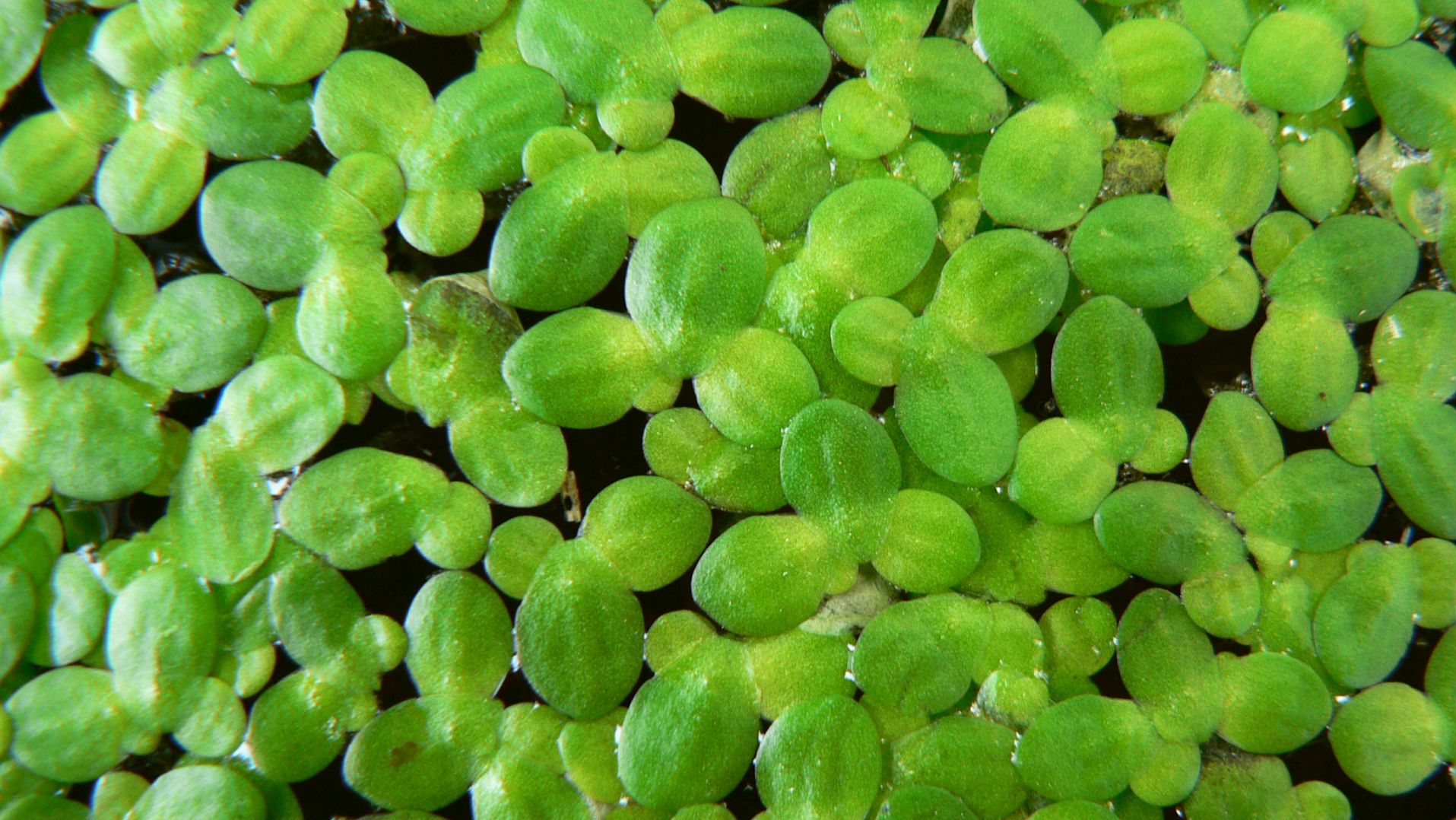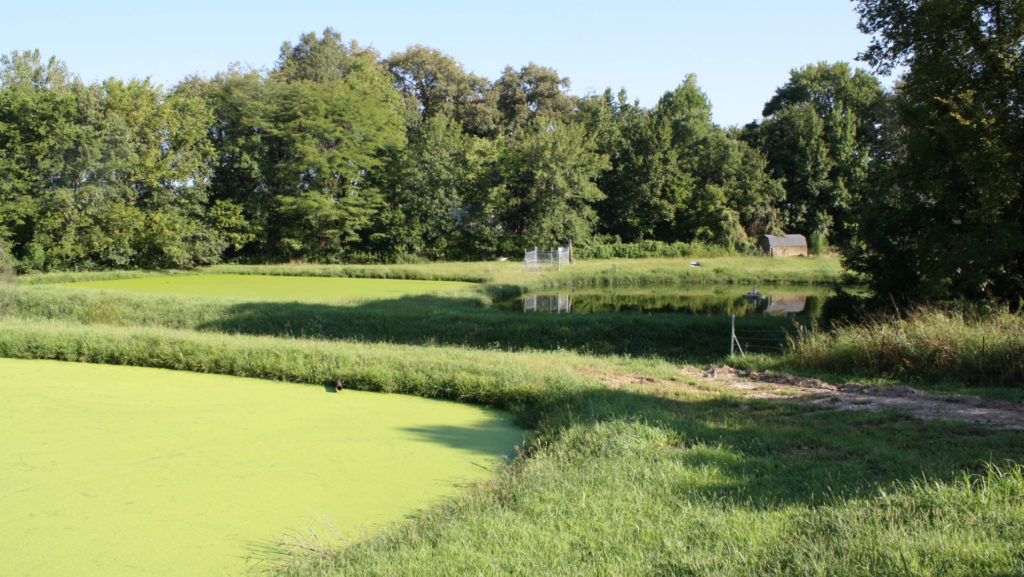
Duckweed, or water lens, is a rapidly growing, invasive aquatic plant that loves wastewater lagoons due to the presence of nutrients ammonia and phosphorus. Since summertime is high season for lagoon duckweed, it seems like a good time to talk about it—what it is, what it does, and whether it’s a friend or a foe in your wastewater lagoon.
What is lagoon duckweed?
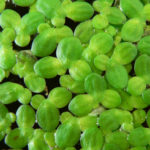 Duckweed is a small, leafy flowering plant that proliferates rapidly in stagnant or slow-moving water. It’s found all over the world, except in the coldest environments. It spreads easily, either through water channels or by hitching a ride on unsuspecting waterfowl. Once it lands in a nice quiet spot, it proliferates rapidly, doubling its coverage in less than two days with the potential to completely cover an acre of surface in 45 days.
Duckweed is a small, leafy flowering plant that proliferates rapidly in stagnant or slow-moving water. It’s found all over the world, except in the coldest environments. It spreads easily, either through water channels or by hitching a ride on unsuspecting waterfowl. Once it lands in a nice quiet spot, it proliferates rapidly, doubling its coverage in less than two days with the potential to completely cover an acre of surface in 45 days.
Duckweed is often mistaken for algae since they’re both green and cover water surfaces. Although they may look alike from a distance, algae and duckweed are competitors.
Duckweed vs. algae
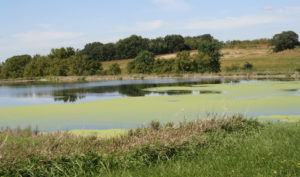 Despite their similarities, duckweed and algae are the Felix and Oscar of aquatic plants. Duckweed forms in discrete individual flowers, while filamentous algae form in mats. To tell the difference, stick your hand in: Duckweed will move out of the way, while algae will stay clumped together. Overabundant duckweed outcompetes algae, blocking the sunlight that algae need to grow, reducing dissolved oxygen (DO) levels and BOD treatment. Less algae, especially in a polishing pond, can be a good thing: Since most effluent lagoon total suspended solids (TSS) is algae, more duckweed means less TSS.
Despite their similarities, duckweed and algae are the Felix and Oscar of aquatic plants. Duckweed forms in discrete individual flowers, while filamentous algae form in mats. To tell the difference, stick your hand in: Duckweed will move out of the way, while algae will stay clumped together. Overabundant duckweed outcompetes algae, blocking the sunlight that algae need to grow, reducing dissolved oxygen (DO) levels and BOD treatment. Less algae, especially in a polishing pond, can be a good thing: Since most effluent lagoon total suspended solids (TSS) is algae, more duckweed means less TSS.
Duckweed is a natural water filter
Duckweed is very effective at uptaking carbon, nitrogen, phosphorus, pathogens, and toxins, acting as a natural water filter. Sounds great, except duckweed doesn’t process or metabolize any of the bad stuff—it just holds it. After a while, the duckweed dies, sinks to the bottom, and releases all the nutrients and contaminants back into the water. To be effective as wastewater treatment, duckweed needs to be removed and disposed of appropriately.
Read more about effective lagoon nutrient removal.
Controlled duckweed is used in wastewater treatment, especially in hot climates, and particularly in developing countries. Sometimes arranged within a surface grid system to ensure consistent coverage, the duckweed is allowed to overtake the surface of the lagoon. Supplemental mechanical aeration prevents the anaerobic conditions that duckweed creates. The duckweed uptakes the contaminants and nutrients from the water, and is then harvested and disposed of. Ongoing studies have been evaluating the potential of using harvested duckweed for animal fodder or biofuel.
Duckweed creates an anaerobic environment
When it comes to wastewater lagoons, the lack of dissolved oxygen is bad. (Read our previous article, Troubleshooting Low Lagoon Dissolved Oxygen, for an in-depth look.) Duckweed is a DO killer, blocking the oxygen-transferring interface between the surface of the lagoon and the atmosphere. And because duckweed inhibits algal growth, the lagoon doesn’t receive any of the natural oxygenation that algae provide. Lack of dissolved oxygen prevents lagoon bacteria from breaking down BOD, resulting in effluent violations and objectionable odors.
Duckweed also disrupts pathogen die off, because solar radiation is critical to the lagoon disinfection process and the blanket of duckweed prevents sunlight from penetrating the water.
How to get rid of lagoon duckweed
Unless specifically designed as a method of wastewater treatment, where it’s kept in check, evenly distributed, harvested regularly, and disposed of safely, duckweed on a treatment lagoon is a problem. It indicates high nutrient loads of ammonia or phosphorus, and will lead to low DO and high BOD, and the potential for septic conditions, odors, and permit violations. If you have pervasive lagoon duckweed in a treatment cell, it must be dealt with. Here are some options:
Remove physically: Duckweed can be pushed to the edges of the lagoon with a firehose or powered sprayer, and raked up from the shore. Because duckweed is laden with nutrients and pathogens, it must be disposed of in a manner that prevents these contaminants from being released into a waterway. This is a very labor intensive and time consuming method, and, because duckweed grows so rapidly, nearly impossible for an operator to stay on top of.
Use chemical herbicides: Aquatic herbicides can be very effective, but may be restricted, especially for discharging lagoons. Check with your local environmental department for recommendations and permits as required, as these chemicals can affect water quality. It’s much easier and less expensive to spot-treat new duckweed infestations before they get out of hand. Also, if too much duckweed is killed off all at once, the decomposing plants will create an oxygen demand that will exacerbate anaerobic conditions and odors.
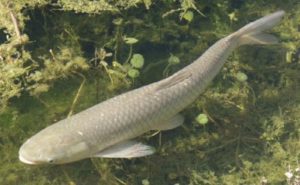
Go Fish: The United States Forest Service used grass carp to control duckweed in a ranger station wastewater lagoon in Idaho. Nine triploid carp, which are incapable of reproduction, were added to the lagoon; after a year, most of the duckweed was gone. The carp didn’t interfere with the wastewater treatment, and were much less expensive than the cost of manually removing duckweed from the lagoon. This can be an effective natural solution if there is sufficient DO to support the fish and if there are barriers in place to keep them from escaping.
Improve surface action: Duckweed likes stagnant water, so any movement on the water’s surface will prevent it from taking over. Enhance wind action by removing any barriers, such as plants, trees, or solid fences. The mixing capabilities of Triplepoint’s Ares Aerator® keep the surface of the lagoon in motion, preventing duckweed and algae from proliferating while maximizing aeration and oxygen transfer.
Lagoon Duckweed: Foe
Although duckweed is a fascinating and useful plant, it is not a friend to the typical wastewater lagoon, except perhaps in a polishing cell, where it’s the lesser of two evils.
If a polishing cell has enough nutrient content to support the growth of algae or duckweed, duckweed is highly preferable. The polishing cell is intended to settle out any remaining solids before discharge, so having algal blooms defeats the purpose by adding solids back in. A cover of duckweed will prevent TSS violations by keeping algae in check.
As summer approaches, it’s important to keep duckweed from proliferating in your treatment lagoon, where it can cause anaerobic conditions, which leads to low DO, high BOD, and poor quality effluent.
